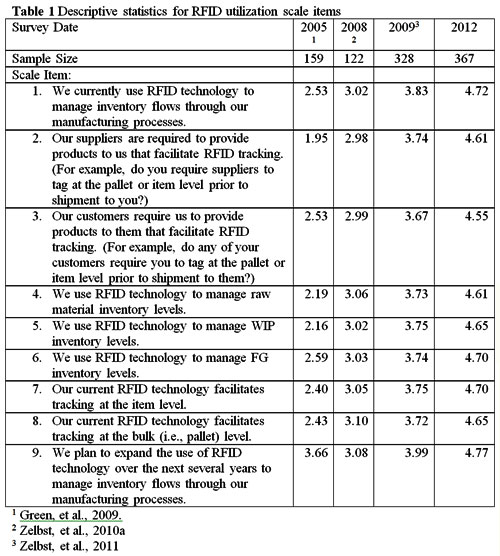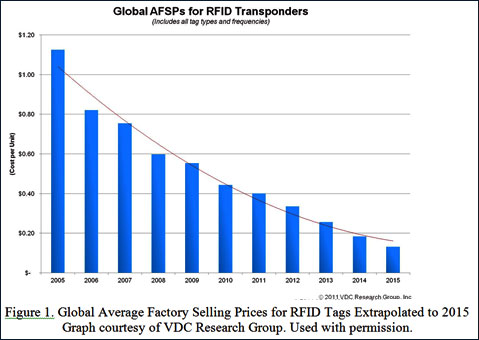Jun 11, 2012A multi-year survey conducted by researchers at Sam Houston State University and Southern Arkansas University shows steady growth throughout the past eight years in the utilization of radio frequency identification systems by U.S. manufacturers to track inventory. During the span of time covered by the study (2005 to 2012), there has been an increase in the number of U.S. manufacturers requiring suppliers to provide RFID-tagged materials in order to facilitate inventory tracking. Respondents also reported increasing plans to expand their use of RFID systems over the next several years, in order to monitor inventory flow throughout their manufacturing processes. This increased utilization correlates with dramatic decreases in RFID tag prices, which make the technology more cost-justifiable.
Radio frequency identification is an automatic identification and data capture (AIDC) technology that transmits information encoded on tags (transponders) to readers, and then to a computer database. RFID offers a number of advantages over other AIDC technologies, such as bar codes: it does not require optical line of sight for communication, multiple tags can be read simultaneously, it is capable of communicating over greater distances, tags can provide rewritable memory, and it can interface with environmental sensors, as well as provide enhanced security features (Zelbst & Sower, 2012).
RFID offers many potential benefits to manufacturers in better managing their inventory and supply chains. The technology's usage has reportedly enabled manufacturers to reduce cycle times, decrease safety-stock levels and improve changeover times (Zebra, 2011). But perhaps the greatest benefit of RFID usage is the ability to make decisions with near-real-time information (Zelbst & Sower, 2012).
Some (Napolitano, 2012) argue that while "there are more drivers than ever pushing RFID's adoption... a lack of education is holding back companies from investing and innovating." To address this issue, our research group has conducted four studies during the past eight years regarding RFID's use and effect on performance in the United States' manufacturing industry. Four times throughout this period, we employed an online data service to survey U.S. manufacturing managers holding operations-related managerial or supervisory positions and operational positions, about how they used RFID within their companies. Respondents reported holding their current positions for an average of at least 6.9 years. Approximately two-thirds of those who responded selected one of 18 specific Standard Industrial Classification (SIC) categories, with the remaining third choosing the more general category, "other manufacturing." Mean organization size, as measured by annual revenues, varied from $1.5 billion to $1.9 billion.
The results show a dramatic increase in the use of RFID to manage all forms of inventory: raw materials (RM), work-in-progress (WIP) and finished goods (FG). There is also a dramatic increase in the number of organizations requiring suppliers to provide RFID-enabled products, as well as a rise in the number of suppliers mandating that the organizations supply materials fitted with RFID tags so that they can be tracked. The tracking of materials and goods at both the pallet and item levels trended upward over the eight years covered by the study, as indicated by the mean response to items 7 and 8. Over the last five years of the study, manufacturers' intent to expand the use of RFID during the next several years has increased.
One factor underlying the increased usage of RFID is that the technology has become economically feasible for more manufacturing organizations as tag costs have dramatically declined since 2005. As Figure 1 illustrates, the average factory selling price (AFSP) for all types of RFID transponders has decreased from more than $1.10 in 2005 to less than $0.40 this year. Simply extrapolating that trend predicts a tag AFSP below 20 cents by 2015. Research carried out by Rice University scientists and others, however, predicts that tag AFSP can be reduced to 4 cents or less (Allen et al., 2009).
The increasing use of RFID in manufacturing is not surprising, given the transponder cost reductions and the increased understanding of the impact that RFID's use has on organizations adopting the technology. The broader studies associated with the data collections summarized above have provided insights into RFID's effect on an organization.
• RFID usage, in and of itself, was found to have no effect on supply chain performance (Zelbst et al., 2010b). This suggests that organizations that implement radio frequency identification with no real objectives, or that do not plan to integrate it into their supply chain management system, will derive little benefit regarding supply chain performance. For example, organizations that implement RFID simply because a customer mandates they do so, but that do not take internal advantage of the technology's capabilities, simply incur an additional cost of doing business. The only benefit of such an implementation is continued sales to that customer.
• RFID usage is associated with improved supply chain performance, by providing more accurate and timely information upon which to base decisions. One study showed that the technology's usage directly affects the sharing of supply chain information—which, in turn, positively affects supply chain performance (Zelbst et al., 2010b).
• RFID usage has been shown to positively relate to increased operational performance (Zelbst et al., 2010a).
• European pallet and container pooling services company CHEP increased its operational performance by using RFID to track its containers into and out of pallet and container pool services facilities. By tagging 150,000 containers, the company improved its container accountability, enhanced its tracking and inspection data, and increased its brand recognition (Wessel, 2008).
• RFID usage has been shown to positively relate to increased efficiency and effectiveness outcomes—which, in turn, lead to increased organizational and supply chain performance (Zelbst et al., 2012).
• The Bon Secours Richmond Health System achieved $2 million in annual savings on equipment rental, losses and service costs (see Bon Secours Richmond Finds RFID Saves $2 Million Annually); increased equipment utilization from 40 percent to 90 percent; reduced operating room (OR) turnover time; increased productivity; and decreased overtime through the use of RFID tags for equipment and patients, and by integrating the RFID system with the hospital's computer system (Healthcare Financial Management Association, 2011).
• RFID utilization has been shown to positively relate to increased organizational agility, thereby improving both operational and logistics performance (Zelbst et al., 2011). The technology also increases organizational agility, by providing near-real-time information to an organization's decision-making processes. This facilitates quicker reaction time to changes, thereby leading to improved operation and logistics performance.
Victor Sower is a Distinguished Professor of Operations Management at Sam Houston State University. Kenneth Green is the LeMay Professor of Technology at Southern Arkansas University. Pamela Zelbst is an associate professor of management and the director of the Sower Business Technology Laboratory at Sam Houston State University. Morgan Thomas is a recent honors graduate of the Southern Arkansas University's College of Business.
References
Alien Technology Corp. (2008). http://www.alientechnology.com.
Allen, M., L. Jaakkola, K. Munnila, & H. Seppa (2009). "Applicability of Metallic Nanoparticle Inks in RFID Applications." IEEE Transactions on Components and Tracking Technologies 32(2), 325-332.
Green Jr., K., D. Whitten, & R. Inman. (2009) "The Impact of RFID Technology Utilization on Supply Chain Productivity and Organizational Performance." International Journal of Innovation and Learning 6(2), 147-162.
Healthcare Financial Management Association (2011). http://www.hfma.org.
Laird, M. (2012). Director, RFID, VDC Research Group. Personal Communication, 4 May.
Napolitano, M. (2012) "RFID Surges Ahead." Logistics Management 51(4), 47-49).
Wessel, R. (2008). "CHEP Tracks Auto-Part Containers in Europe." RFID Journal, /articles/view?4442.
Zebra (2011). Unchaining the Value of RFID for Unmatched Flexibility and for Fast ROI. Lincolnshire, IL: Zebra Technologies.
Zelbst, P., K. Green, & V. Sower. (2010a) "Impact of RFID Technology Utilization on Operational Performance." Management Research Review 33(10), 994-1004.
Zelbst, P., K. Green, V. Sower, & G. Baker. (2010b) "RFID Utilization and Information Sharing: The Impact on Supply Chain Performance." Journal of Business & Industrial Marketing 25(8), 582-589.
Zelbst, P., K. Green, V. Sower, & R. Abshire. (2011) "Impact of RFID Technology Utilization on
Organizational Agility." Journal of Computer Information Systems 52(1), 24-33.
Zelbst, P., K. Green, V. Sower, & P. Reyes. (2012) "The Impact of RFID Utilization on Manufacturing Effectiveness and Efficiency." International Journal of Operations & Production Management 32(3), 329-350.
Zelbst, P., & V. Sower. (2012). RFID for the Supply Chain and Operations Professional. New York, NY: Business Expert Press.




